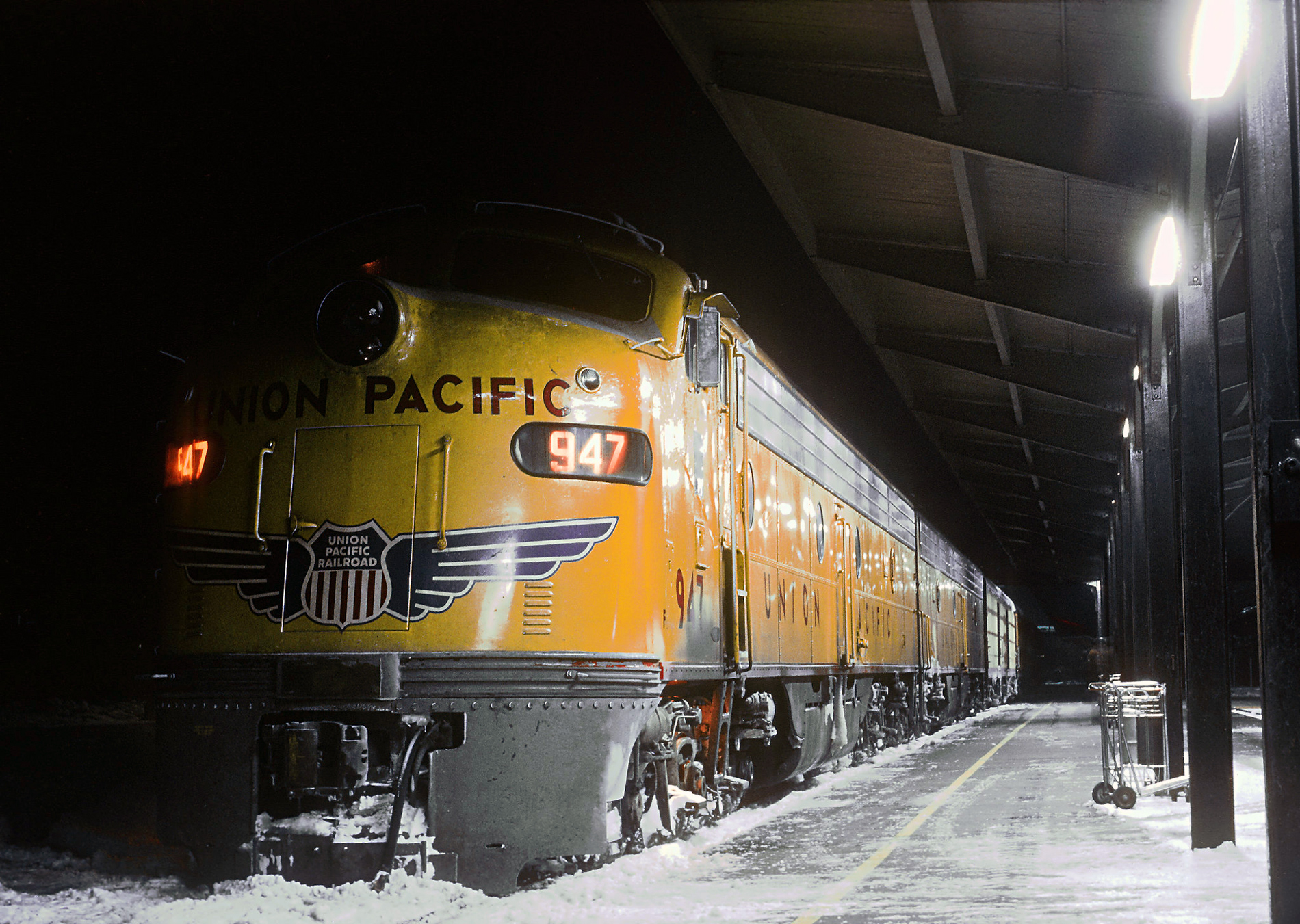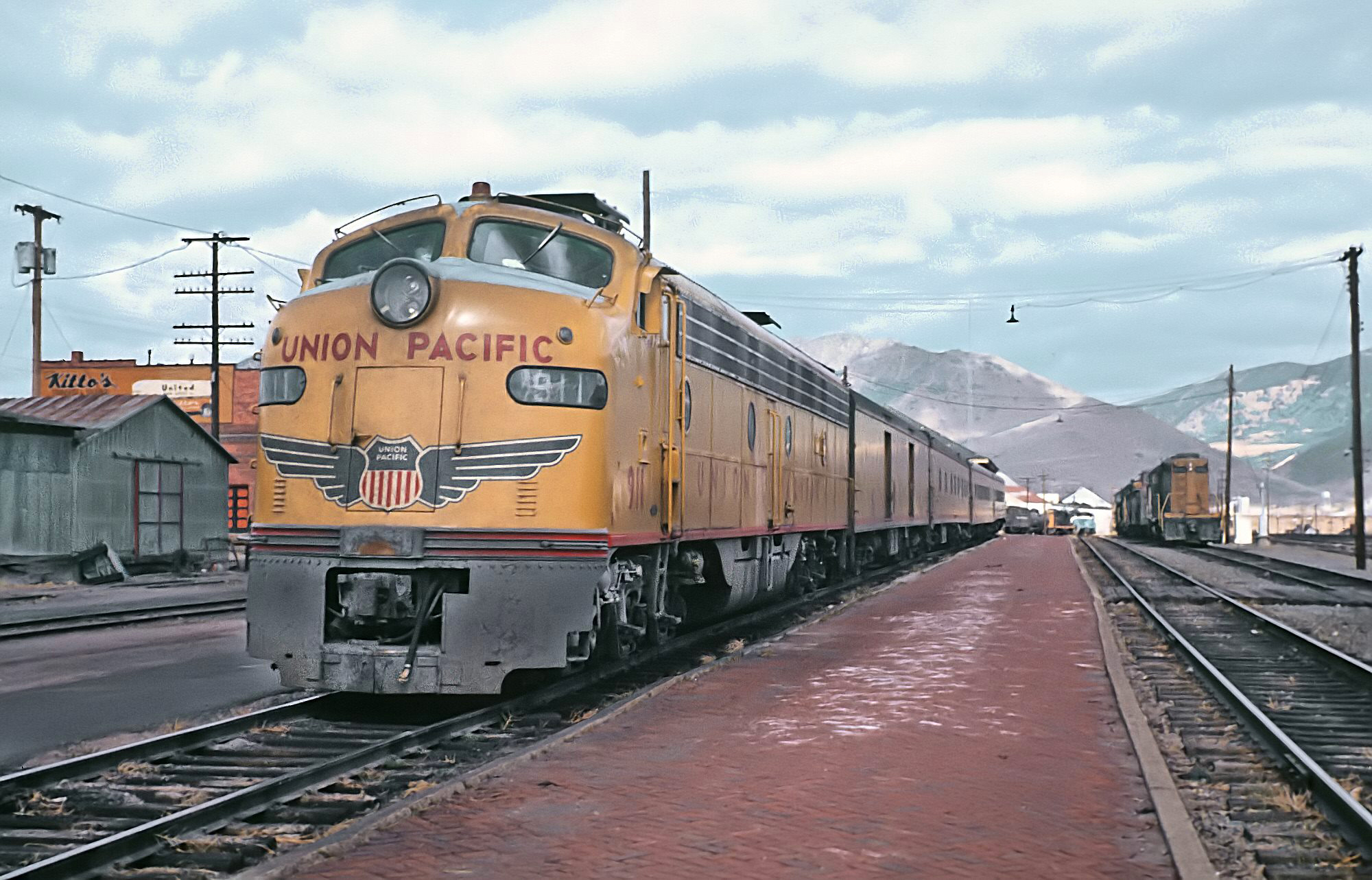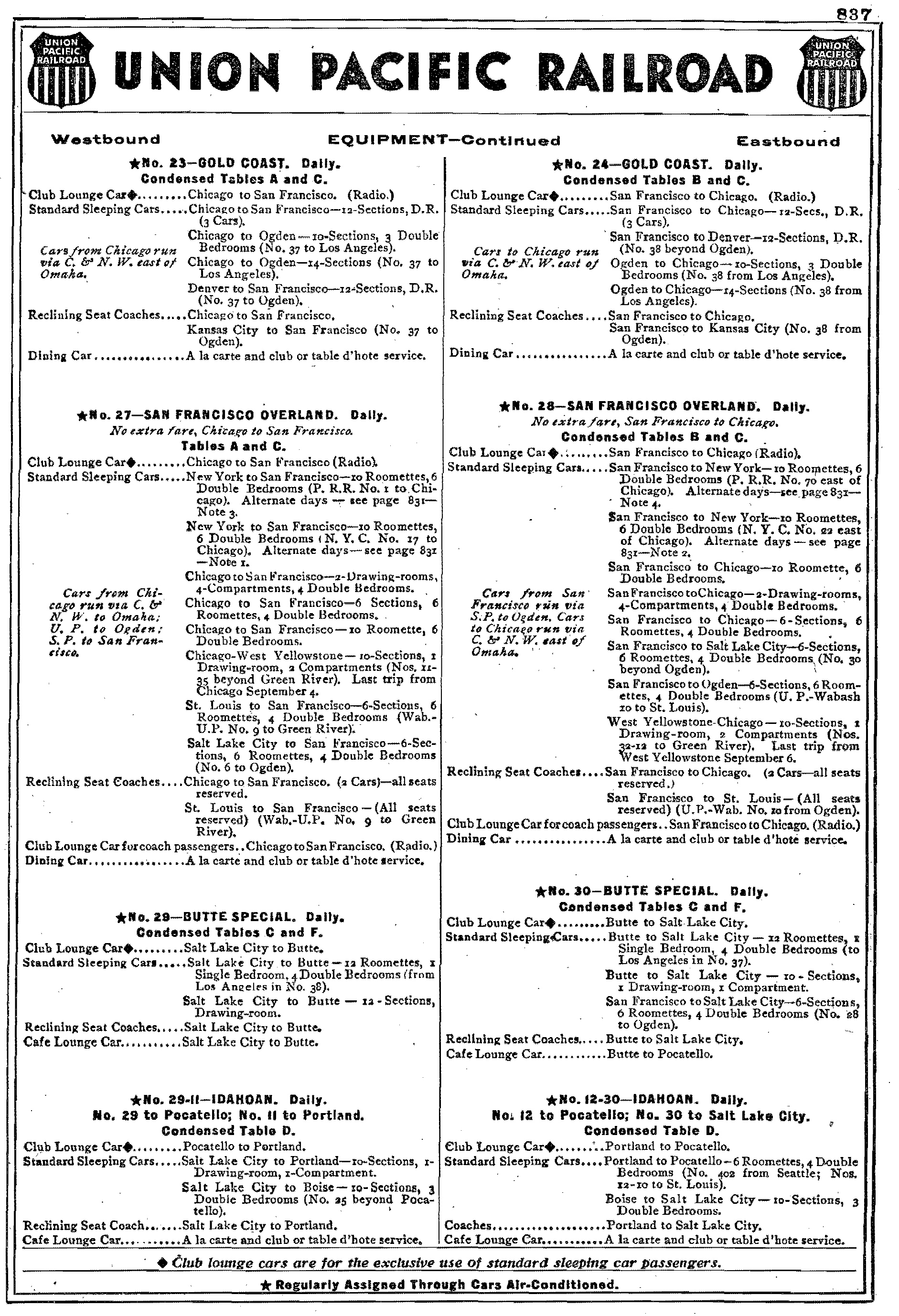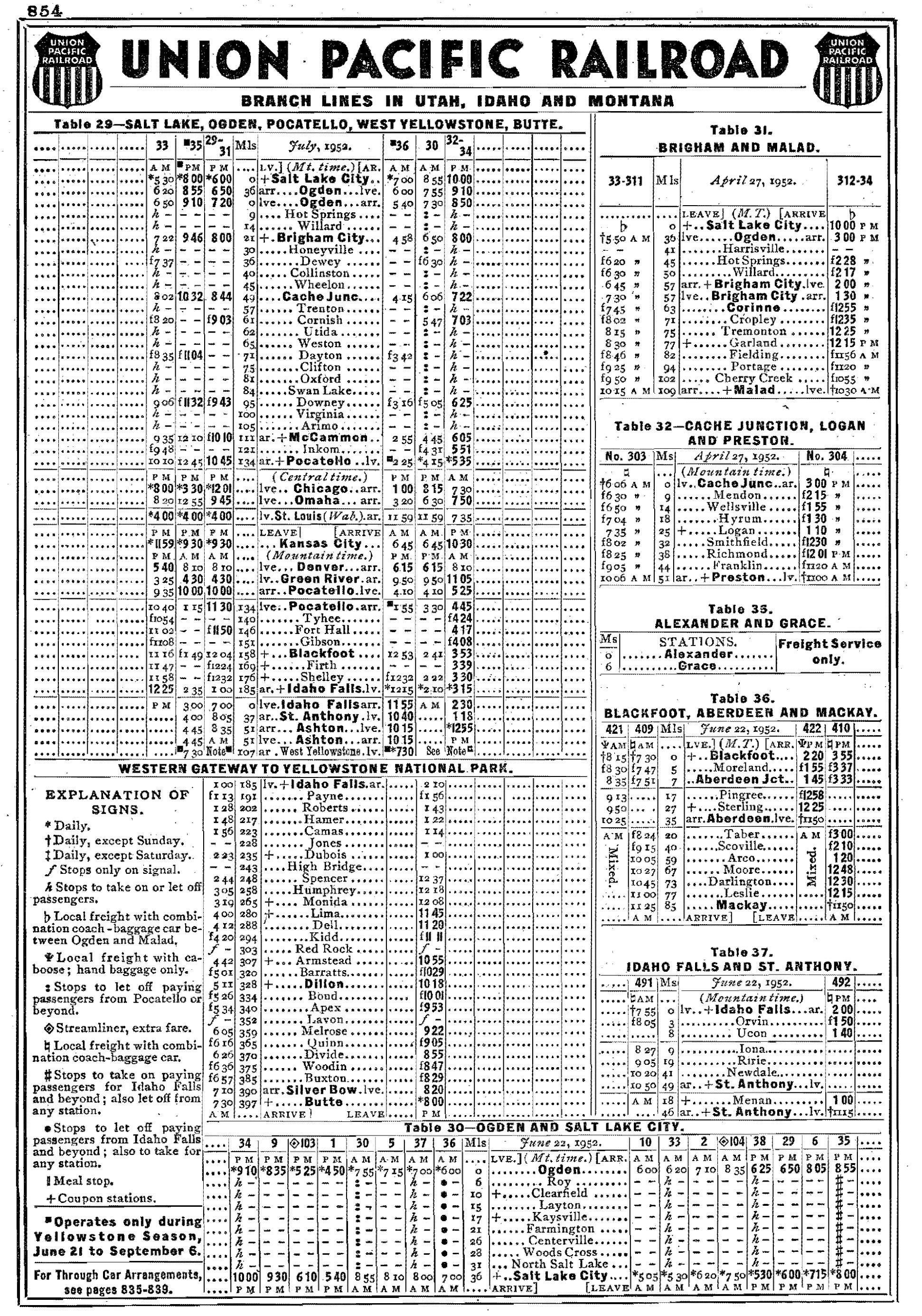The "Butte Special": Butte - Salt Lake City
Last revised: September 10, 2024
By: Adam Burns
The Union Pacific is long remembered for fielding an impressive passenger fleet during the 20th century that always provided top-level service. If there was ever what one would consider a secondary run on the railroad the Butte Special would fit that description.
This train operated as a regional connecting Salt Lake City and Butte, Montana along UP's Montana Division where it connected with the Northern Pacific and Milwaukee Road.
Once a heavyweight it later fielded streamlining and offered quite an array of amenities, providing one of the last vestiges of Pullman service meals anywhere in the country.
During the 1960s UP attempted to cancel the train with little success and it continued running quietly until the start of Amtrak in 1971.
The Union Pacific's celebrated array of streamliners are still widely talked about today. Who could forget the opulent City fleet, the Portland Rose, Forty-Niner, or the Challenger?
Photos
 Union Pacific E9A #947 has arrived at Salt Lake City with train #36, the southbound "Butte Special," at around 7 AM on December 19, 1970. Roger Puta photo.
Union Pacific E9A #947 has arrived at Salt Lake City with train #36, the southbound "Butte Special," at around 7 AM on December 19, 1970. Roger Puta photo.History
The Butte Special was not as well known as these but true to the railroad's form it blossomed into a fine operation. The Union Pacific reached southwestern Montana through a predecessor known as the Utah Northern Railroad.
This narrow-gauge system had been promoted by Mormon interests but failed after a financial panic during the 1870s. It was reorganized by the UP as the Utah & Northern Railway during April of 1878 and completed to Butte (via Pocatello, Idaho) by December of 1881.
The line was then standard-gauged six years later in 1887 and became a part of UP's Oregon Short Line & Utah Northern Railway subsidiary in 1889.
About ten years later a branch to reach the Yellowstone National Park was completed in 1908. Eventually, this section of the Union Pacific system was known wholly as its Montana Division.
Passenger service on the route to Butte commenced soon after and a train known as the Butte Special became the line's top service (and the only UP train operating on a north-south routing); it connected Salt Lake City/Ogden with Butte via Pocatello and also provided summertime service to Yellowstone.
Although listed in UP's timetable as a named train, the Yellowstone Special, this "train" actually was only an additional section of coaches and sleepers provided on either the Butte Special, Portland Rose, or the City of Portland. The Butte Special best remembered today took form during roughly the 1920s.
 Union Pacific E9A #911 is ahead of train #36, the "Butte Special," which as arrived at Butte, Montana in September, 1970. Rick Burn photo.
Union Pacific E9A #911 is ahead of train #36, the "Butte Special," which as arrived at Butte, Montana in September, 1970. Rick Burn photo.After this time one could see a variety of large steamers pulling the train although it most often used Class MT Mountains.
Officially it was listed as #29 (northbound) and #30 (southbound) with a typical consist including:
- Several mail/express head end cars (upwards of a half-dozen)
- Railway Post Office (RPO)
- Two or three reclining seat coaches
- Café-lounge
- Up to three sleepers (one serving Butte to Salt Lake, another running through to Los Angeles, and a connecting Southern Pacific section via Oakland)
When the streamliner era hit the industry, spurred by none other than Union Pacific' own M-10000 launched in February of 1934 the Butte Special began fielding rebuilt heavyweight cars with semi-streamlining. During the 1940s the equipment also wore UP's brief two-grey passenger livery, a simple but elegant scheme that also adorned steam locomotives.
Schedule (January, 1970)
| Time/Leave (Train #35) | Time/Arrive (Train #36) | |
|---|---|---|
| 7:30 PM (Dp) | 7:00 AM (Ar) | |
| 8:20 PM (Ar) | 5:50 AM (Dp) | |
| 8:55 PM (Dp) | 5:35 AM (Ar) | |
| 11:55 PM (Ar) | 2:45 AM (Dp) | |
| 12:25 AM (Dp) | 2:05 AM (Ar) | |
| 1:30 AM (Ar) | 12:55 AM (Dp) | |
| 1:40 AM (Dp) | 12:45 AM (Ar) | |
| 7:30 AM (Ar) | 7:30 PM (Dp) |
When the railroad began a concentrated effort to dieselize its motive power fleet after World War II it had a batch of F3s, delivered between 1947 and 1949, equipped for passenger service (steam generators).
Later rebuilt into F7 specifications these normally-assigned freight locomotives continued to pull the Special until the railroad acquired batches of true passenger power rom the early 1950s through 1964 in the form of Electro-Motive E8s and E9s (Fs, however, could still be found heading the train through the 1960s).
It was during this time that the train was clad in Union Pacific's classic Armour yellow and gray passenger scheme thanks to these new diesels along with the lightweight equipment. It is fascinating that for a train serving a town of no greater than 50,000 residents (Butte) it offered an impressive level of conveniences.
Consist (1952)
Its most impressive feature was a 6-6-4 American View sleeper that had two sections converted to offer light meals provided through Pullman. While only a dinette service this unique setup is still talked about today for those lucky enough to have experienced it.
Even as patronage declined during the 1960s Union Pacific kept the train immaculate with all-matching, clean equipment. In 1960 it stopped providing direct service to West Yellowstone and in 1965 discontinued all rail service to the national park.
The major blow came in 1967 when the train lost its lucrative U.S. mail contract and was subsequently curtailed to thrice weekly only. In its final years the Special was listed as #35 (northbound running on Thursday, Saturday, and Monday) and #36 (southbound running on Friday, Sunday, and Tuesday).
Timetable (1952)
The Union Pacific petitioned the Interstate Commerce Commission to cancel the train after this time but had little success in doing so. As such, the train continued on until Amtrak normally carrying a baggage, two reclining seat coaches, and that unique 6-6-4 dinette/sleeper, the last of its kind in the country to offer Pullman meal service.
Through the end, in typical UP fashion the Butte Special remained an all-matching train with an E9A or E8A for power and the four-car consist mentioned above. Perhaps only the Santa Fe equaled the UP in this capacity as both railroads simply did not let services slip despite mounting losses right until Amtrak took over.
Recent Articles
-
New Hampshire Dinner Train Rides In N. Conway!
Jan 16, 26 10:47 AM
Tucked into the heart of New Hampshire’s Mount Washington Valley, the Conway Scenic Railroad is one of New England’s most beloved heritage railways -
Oregon Dinner Train Rides Near Mt. Hood!
Jan 16, 26 10:44 AM
The Mt. Hood Railroad is the moving part of that postcard—a century-old short line that began as a working railroad. -
Maryland's - Wine Tasting - Train Rides
Jan 15, 26 02:59 PM
This article delves into the enchanting world of wine tasting train experiences in Maryland, providing a detailed exploration of their offerings, history, and allure. -
Colorado's - Wine Tasting - Train Rides
Jan 15, 26 02:46 PM
To truly savor these local flavors while soaking in the scenic beauty of Colorado, the concept of wine tasting trains has emerged, offering both locals and tourists a luxurious and immersive indulgenc… -
Iowa ~ Wine Tasting ~ Train Rides
Jan 15, 26 02:36 PM
The state not only boasts a burgeoning wine industry but also offers unique experiences such as wine by rail aboard the Boone & Scenic Valley Railroad. -
Georgia's Wine Train Rides In Cordele!
Jan 15, 26 02:26 PM
While the railroad offers a range of themed trips throughout the year, one of its most crowd-pleasing special events is the Wine & Cheese Train—a short, scenic round trip designed to feel like a t… -
Indiana ~ Murder Mystery ~ Dinner Train Rides
Jan 15, 26 02:22 PM
This piece explores the allure of murder mystery trains and why they are becoming a must-try experience for enthusiasts and casual travelers alike. -
Ohio ~ Murder Mystery ~ Dinner Train Rides
Jan 15, 26 02:10 PM
The murder mystery dinner train rides in Ohio provide an immersive experience that combines fine dining, an engaging narrative, and the beauty of Ohio's landscapes. -
Nevada Dinner Train Rides In Ely!
Jan 15, 26 02:01 PM
If you’ve ever wished you could step through a time portal into the hard-working world of a 1900s short line the Nevada Northern Railway in Ely is about as close as it gets. -
Michigan Dinner Train Rides In Owosso!
Jan 15, 26 09:46 AM
The Steam Railroading Institute is best known as the home of Pere Marquette #1225 and even occasionally hosts a dinner train! -
Arizona's - Wine Tasting - Train Rides
Jan 14, 26 02:04 PM
For those who want to experience the charm of Arizona's wine scene while embracing the romance of rail travel, wine tasting train rides offer a memorable journey through the state's picturesque landsc… -
Arkansas's - Wine Tasting - Train Rides
Jan 14, 26 01:57 PM
This article takes you through the experience of wine tasting train rides in Arkansas, highlighting their offerings, routes, and the delightful blend of history, scenery, and flavor that makes them so… -
Tennessee ~ Murder Mystery ~ Dinner Train Rides
Jan 14, 26 01:42 PM
Amidst the rolling hills and scenic landscapes of Tennessee, an exhilarating and interactive experience awaits those with a taste for mystery and intrigue. -
California ~ Murder Mystery ~ Dinner Train Rides
Jan 14, 26 01:26 PM
When it comes to experiencing the allure of crime-solving sprinkled with delicious dining, California's murder mystery dinner train rides have carved a niche for themselves among both locals and touri… -
Illinois ~ Murder Mystery ~ Dinner Train Rides
Jan 14, 26 01:13 PM
Among Illinois's scenic train rides, one of the most unique and captivating experiences is the murder mystery excursion. -
Vermont's - Murder Mystery - Dinner Train Rides
Jan 14, 26 12:57 PM
There are currently murder mystery dinner trains offered in Vermont but until recently the Champlain Valley Dinner Train offered such a trip! -
Massachusetts Dinner Train Rides On Cape Cod!
Jan 14, 26 12:20 PM
The Cape Cod Central Railroad (CCCR) has carved out a special niche by pairing classic New England scenery with old-school hospitality, including some of the best-known dining train experiences in the… -
Maine Dinner Train Rides In Portland!
Jan 14, 26 11:31 AM
While this isn’t generally a “dinner train” railroad in the traditional sense—no multi-course meal served en route—Maine Narrow Gauge does offer several popular ride experiences where food and drink a… -
Kentucky Dinner Train Rides In Bardstown!
Jan 13, 26 01:14 PM
The essence of My Old Kentucky Dinner Train is part restaurant, part scenic excursion, and part living piece of Kentucky rail history. -
Kansas Dinner Train Rides In Abilene!
Jan 13, 26 12:44 PM
If you’re looking for a heritage railroad that feels authentically Kansas—equal parts prairie scenery, small-town history, and hands-on railroading—the Abilene & Smoky Valley Railroad (A&SV) delivers. -
Michigan ~ Murder Mystery ~ Dinner Train Rides
Jan 13, 26 11:24 AM
Among the lesser-known treasures of this state are the intriguing murder mystery dinner train rides—a perfect blend of suspense, dining, and scenic exploration. -
Virginia's - Murder Mystery - Dinner Train Rides
Jan 13, 26 11:11 AM
Among the state's railroad attractions, murder mystery dinner trains stand out as a captivating fusion of theatrical entertainment, fine dining, and scenic travel. -
Arizona Dinner Train Rides At The Grand Canyon!
Jan 13, 26 10:59 AM
While the Grand Canyon Railway does not offer a true, onboard dinner train experience it does offer several upscale options and off-train dining. -
Georgia Dinner Train Rides In Nashville!
Jan 13, 26 10:27 AM
If you’ve ever wished you could slow down, trade traffic for jointed rail, and let a small-town landscape roll by your window while a hot meal is served at your table, the Azalea Sprinter delivers tha… -
Indiana Valentine's Train Rides
Jan 12, 26 04:27 PM
If you’ve ever wished you could step into a time when passenger trains were a Saturday-night treat and a whistle echoing across farm fields meant “adventure,” the Nickel Plate Express delivers that fe… -
Ohio Valentine's Train Rides!
Jan 12, 26 04:20 PM
The Hocking Valley Scenic Railway offers one of the region’s most atmospheric ways to experience the Hocking Hills area: from the rhythmic click of jointed rail to the glow of vintage coaches rolling… -
Wisconsin's - Wine Tasting - Train Rides
Jan 12, 26 03:10 PM
Wisconsin might not be the first state that comes to mind when one thinks of wine, but this scenic region is increasingly gaining recognition for its unique offerings in viticulture. -
California's - Wine Tasting - Train Rides
Jan 12, 26 02:34 PM
This article explores the charm, routes, and offerings of these unique wine tasting trains that traverse California’s picturesque landscapes. -
Wisconsin Scenic Train Rides In North Freedom!
Jan 12, 26 02:20 PM
The Mid-Continent Railway Museum is a living-history museum built around the sights, sounds, and everyday rhythms of small-town and shortline railroading in the early 20th century, what the museum cal… -
Vermont Scenic Train Rides In Burlington!
Jan 12, 26 01:18 PM
Today, GMRC is best known by many travelers for its Burlington-based passenger experiences—most famously the Champlain Valley Dinner Train and the sleek, limited-capacity Cocktails on the Rails. -
Maryland's - Murder Mystery - Dinner Train Rides
Jan 12, 26 01:03 PM
Maryland is known for its scenic landscapes, historical landmarks, and vibrant culture, but did you know that it’s also home to some of the most thrilling murder mystery dinner trains? -
Minnesota's - Murder Mystery - Dinner Train Rides
Jan 12, 26 12:17 PM
Murder mystery dinner trains offer an enticing blend of suspense, culinary delight, and perpetual motion, where passengers become both detectives and dining companions on an unforgettable journey. -
Vermont Dinner Train Rides In Burlington!
Jan 12, 26 12:09 PM
There is one location in Vermont hosting a dedicated dinner train experience at the Green Mountain Railroad. -
Connecticut Dinner Train Rides In Essex!
Jan 12, 26 10:39 AM
Connecticut's rail heritage can be traced back to the industry's earliest days and a few organizations preserve this rich history by offering train rides. The Essex Steam Train also hosts dinner-theme… -
Florida Scenic Train Rides In Parrish!
Jan 11, 26 10:26 PM
The Florida Railroad Museum (FRRM) in Parrish offers something increasingly rare in today’s rail landscape: a chance to ride historic equipment over a surviving fragment of an early-20th-century mainl… -
California's - Wine Tasting - Train Rides
Jan 11, 26 02:28 PM
This article explores the charm, routes, and offerings of these unique wine tasting trains that traverse California’s picturesque landscapes. -
Georgia's - Murder Mystery - Dinner Train Rides
Jan 11, 26 02:07 PM
In the heart of the Peach State, a unique form of entertainment combines the thrill of a murder mystery with the charm of a historic train ride. -
Colorado ~ Murder Mystery ~ Dinner Train Rides
Jan 11, 26 01:43 PM
Nestled among the breathtaking vistas and rugged terrains of Colorado lies a unique fusion of theater, gastronomy, and travel—a murder mystery dinner train ride. -
Minnesota Dinner Train Rides In Duluth!
Jan 11, 26 01:32 PM
One of the best ways to feel the region's history in motion today is aboard the North Shore Scenic Railroad (NSSR), which operates out of Duluth’s historic depot. -
Illinois Dinner Train Rides At Monticello!
Jan 11, 26 12:42 PM
The Monticello Railway Museum (MRM) is one of those places that quietly does a lot: it preserves a sizable collection, maintains its own operating railroad, and—most importantly for visitors—puts hist… -
Alabama's - Wine Tasting - Train Rides
Jan 10, 26 09:29 AM
While the state might not be the first to come to mind when one thinks of wine or train travel, the unique concept of wine tasting trains adds a refreshing twist to the Alabama tourism scene. -
Maryland Dinner Train Rides At WMSR!
Jan 10, 26 09:13 AM
The Western Maryland Scenic Railroad (WMSR) has become one of the Mid-Atlantic’s signature heritage operations—equal parts mountain railroad, living museum, and “special-occasion” night out. -
Arkansas Dinner Train Rides On The A&M!
Jan 10, 26 09:11 AM
If you want a railroad experience that feels equal parts “working short line” and “time machine,” the Arkansas & Missouri Railroad (A&M) delivers in a way few modern operations can. -
South Dakota's - Murder Mystery - Dinner Train Rides
Jan 10, 26 09:08 AM
While the state currently does not offer any murder mystery dinner train rides, the popular "1880 Train" at the Black Hills Central recently hosted these popular trips! -
Wisconsin's - Murder Mystery - Dinner Train Rides
Jan 10, 26 09:07 AM
Whether you're a fan of mystery novels or simply relish a night of theatrical entertainment, Wisconsin's murder mystery dinner trains promise an unforgettable adventure. -
Missouri's - Murder Mystery - Dinner Train Rides
Jan 10, 26 09:05 AM
Missouri, with its rich history and scenic landscapes, is home to one location hosting these unique excursion experiences. -
Washington ~ Murder Mystery ~ Dinner Train Rides
Jan 10, 26 09:04 AM
This article delves into what makes murder mystery dinner train rides in Washington State such a captivating experience. -
Kentucky Scenic Train Rides At KRM!
Jan 09, 26 11:13 PM
Located in the small town of New Haven the Kentucky Railway Museum offers a combination of historic equipment and popular excursions. -
Washington "Wine Tasting" Train Rides
Jan 09, 26 08:53 PM
Here’s a detailed look at where and how to ride, what to expect, and practical tips to make the most of wine tasting by rail in Washington. -
Kentucky's - Wine Tasting - Train Rides
Jan 09, 26 08:21 PM
Kentucky, often celebrated for its rolling pastures, thoroughbred horses, and bourbon legacy, has been cultivating another gem in its storied landscapes; enjoying wine by rail.



















































